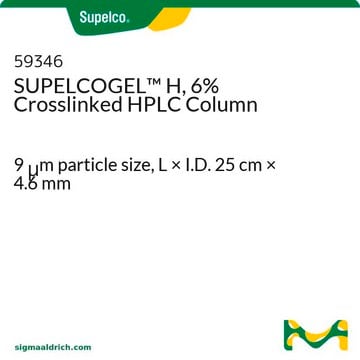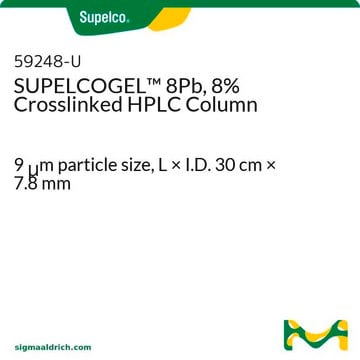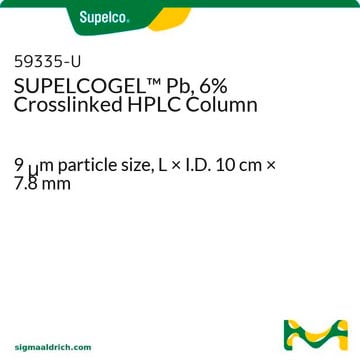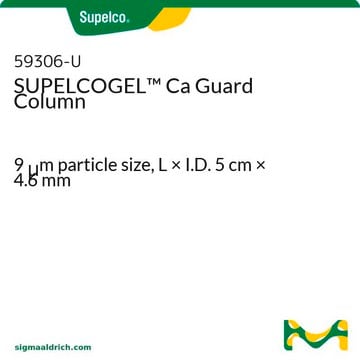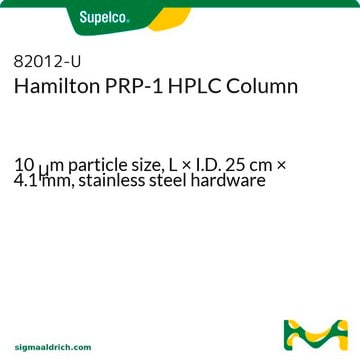If this product has an expiration or retest date, it will be shown on the Certificate of Analysis (COA, CofA). If there is no retest or expiration date listed on the product's COA, we do not have suitable stability data to determine a shelf life. For these products, the only date on the COA will be the release date; a retest, expiration, or use-by-date will not be displayed.
For all products, we recommend handling per defined conditions as printed in our product literature and website product descriptions. We recommend that products should be routinely inspected by customers to ensure they perform as expected.
For products without retest or expiration dates, our standard warranty of 1 year from the date of shipment is applicable.
For more information, please refer to the Product Dating Information document: https://www.sigmaaldrich.com/deepweb/assets/sigmaaldrich/marketing/global/documents/449/386/product-dating-information-mk.pdf
59320-U
SUPELCOGEL™ C610 (9 µm) HPLC Columns
L × I.D. 30 cm × 7.8 mm
Synonyme(s) :
Colonne de CLHP SUPELCOGEL™ 6 % réticulée
Sélectionner une taille de conditionnement
2 730,00 $
Disponible pour expédition le16 avril 2025Détails
Sélectionner une taille de conditionnement
About This Item
2 730,00 $
Disponible pour expédition le16 avril 2025Détails
Produits recommandés
Nom du produit
Colonne de CLHP SUPELCOGEL™ C610H, 6 % réticulée, 9 μm particle size, L × I.D. 30 cm × 7.8 mm
Matériaux
stainless steel column
Niveau de qualité
Agence
suitable for USP L17
Gamme de produits
SUPELCOGEL™
Caractéristiques
endcapped: no
Conditionnement
1 ea of
Paramètres
85 °C max. temp.
Technique(s)
HPLC: suitable
L × D.I.
30 cm × 7.8 mm
Matrice
sulfonated polystyrene/divinylbenzene, spherical particle platform
polymeric
Taille des particules
9 μm
Technique de séparation
ion exclusion
Vous recherchez des produits similaires ? Visite Guide de comparaison des produits
Catégories apparentées
Description générale
Informations légales
Colonne de garde
Code de la classe de stockage
11 - Combustible Solids
Classe de danger pour l'eau (WGK)
WGK 3
Point d'éclair (°F)
Not applicable
Point d'éclair (°C)
Not applicable
Équipement de protection individuelle
Eyeshields, Gloves, type N95 (US)
Faites votre choix parmi les versions les plus récentes :
Certificats d'analyse (COA)
It looks like we've run into a problem, but you can still download Certificates of Analysis from our Documents section.
Si vous avez besoin d'assistance, veuillez contacter Service Clients
Déjà en possession de ce produit ?
Retrouvez la documentation relative aux produits que vous avez récemment achetés dans la Bibliothèque de documents.
Les clients ont également consulté
Articles
Learn more about Bioethanol as a renewable, alternative fuel traditionally produced by the yeast fermentation of sugar.
Protocoles
Increasing corn-to-ethanol conversion and production yield drive discussions on fuel ethanol's economic and environmental viability in biofuel.
Organic acid measurement complements wine quality assessment, influencing color and taste through fermentation control.
-
How can I determine the shelf life / expiration / retest date of this product?
1 answer-
Helpful?
-
-
How is shipping temperature determined? And how is it related to the product storage temperature?
1 answer-
Products may be shipped at a different temperature than the recommended long-term storage temperature. If the product quality is sensitive to short-term exposure to conditions other than the recommended long-term storage, it will be shipped on wet or dry-ice. If the product quality is NOT affected by short-term exposure to conditions other than the recommended long-term storage, it will be shipped at ambient temperature. As shipping routes are configured for minimum transit times, shipping at ambient temperature helps control shipping costs for our customers. For more information, please refer to the Storage and Transport Conditions document: https://www.sigmaaldrich.com/deepweb/assets/sigmaaldrich/marketing/global/documents/316/622/storage-transport-conditions-mk.pdf
Helpful?
-
-
What solutiuon can i use to clean this column?
1 answer-
Cleaning Procedure:
Metal contamination is indicated by shortened retention times and/or skewed peaks. Flush the column in the reverse flow direction following column-specific conditions listed below; do NOT connect the column to the detector during this process. Monitor the system closely to ensure that the maximum pressures are not exceeded. Note that up to 20% ethanol or up to 5% isopropanol may be substituted for the solvents recommended below.
SUPELCOGEL K Mobile Phase: 0.1M K2HPO4 Flow: 0.1 mL/min. Temperature: 85 °C Time: 4-16 hours
SUPELCOGEL Pb & 8 Pb Mobile Phase: 0.1M Pb(NO3)2 Flow: 0.1 mL/min. Temperature: 85 °C Time: 4-16 hours
SUPELCOGEL Ca & 8 Ca Mobile Phase: 0.1M Ca(NO3)2 at a pH of 6.3 Flow: 0.1 mL/min. Temperature: 85 °C Time: 4-16 hours
SUPELCOGEL H, C-610H, C-611, & 8H Mobile Phase: 10/90 CH3CN/0.01NH3PO4 Flow: 0.1 mL/min. Time: 3-4 hours at 25 °C
SUPELCOGEL Ag1 & Ag2 No recommended cleaning procedures.Any additional cleaning procedures are as a last resort to prolong the column life, because the addition of organic solvents will cause the resin to swell resulting in an increase in pressure. Monitor the system closely to insure that the maximum pressures are not exceeded. To remove organic contamination, pump the columns in reverse flow at 0.1 mL/min. with 5:95 acetonitrile:water at 25 °C for 4 hours.
Helpful?
-
-
What is the Department of Transportation shipping information for this product?
1 answer-
Transportation information can be found in Section 14 of the product's (M)SDS.To access the shipping information for this material, use the link on the product detail page for the product.
Helpful?
-
-
What is the % crosslinkage of the SUPELCOGEL Columns?
1 answer-
All SUPELCOGEL resins are 6% crosslinked, except the SUPELCOGEL Ag2, which is 4%.
Helpful?
-
-
How does the Supelcogel™ H differ from the Supelcogel™ C-610H?
1 answer-
Both the Supelcogel™ H and the Supelcogel™ C-610H are microparticulate, macroporous, polystyrene resin columns designed for ion exchange separation of organic acids, carbohydrates, sugar alcohols, and fermentation products. The C-610H is manufactured with a slightly higher cross linkage. Maximum temperature for the Supelcogel™ H is 90° C and for Supelcogel™ C-610H is 60° C. Of the two, only the Supelcogel™ H is available in the 25cm x 4.6mm hardware.
Helpful?
-
Active Filters
Notre équipe de scientifiques dispose d'une expérience dans tous les secteurs de la recherche, notamment en sciences de la vie, science des matériaux, synthèse chimique, chromatographie, analyse et dans de nombreux autres domaines..
Contacter notre Service technique

